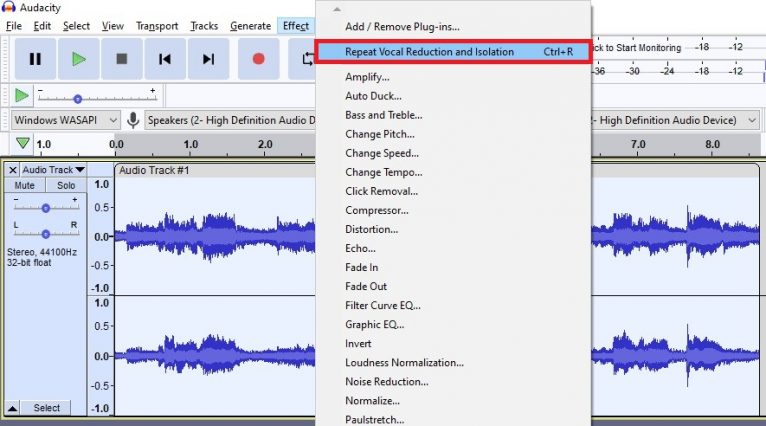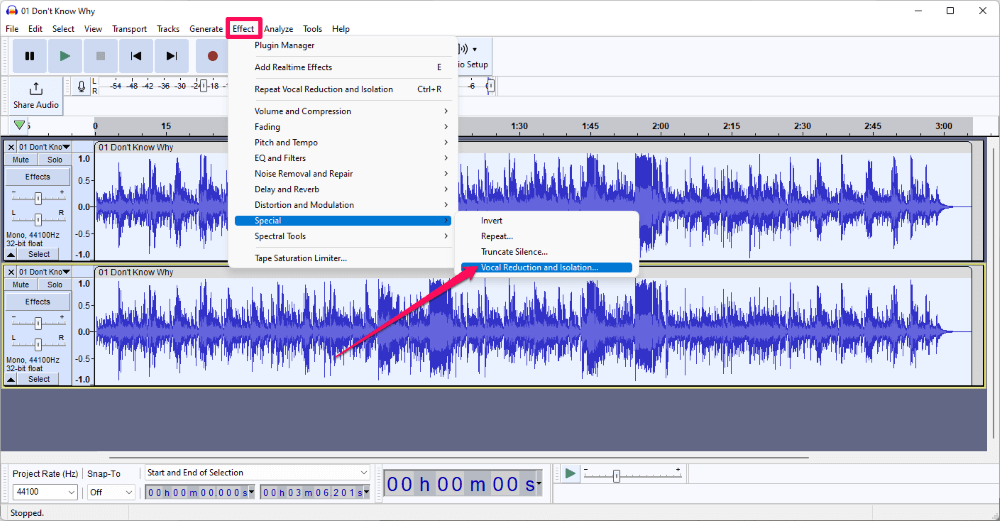Welcome to your one-stop guide for removing vocals from songs using Audacity! Whether you're an aspiring DJ gearing up for a remix or simply want an instrumental version of your favorite track, you’ve landed in the right place. Vocal removal can seem like a daunting task, but with the right tools and techniques, you can do it effectively. In this guide, we’ll break down the process step-by-step so you can create your own karaoke versions or unique mixes in no time!
II. What You Need to Get Started

Before diving into the world of vocal removal, it's essential to gather the right tools and software. Don't worry—getting started is easier than you think! Here's a simple checklist to make sure you have everything you need:
- Audacity Software: First and foremost, you’ll need to download and install Audacity. It’s a free, open-source audio editing software available for Windows, Mac, and Linux. Simply go to the Audacity website and follow the installation instructions.
- Audio Files: Have a few music tracks ready. Make sure they are in a compatible format such as MP3, WAV, or OGG.
- Headphones or Speakers: Good quality headphones or speakers are crucial for listening closely to the audio changes as you work on your tracks.
- A Basic Understanding of Audacity: Familiarize yourself with the interface. It’s user-friendly, but knowing your way around the menus and tools will save you time.
With these essentials, you’ll be ready to embark on your vocal removal journey! So, let’s roll up our sleeves and get started!
Also Read This: How to Record Gameplay on YouTube TV as a Beginner
III. Installing Audacity

Installing Audacity is pretty straightforward and a breeze, even for those who aren't tech-savvy. First off, if you haven't already, head over to the Audacity website to download the software. Depending on your operating system, you'll see options for Windows, macOS, and Linux. Just click on the right version for your system.
Once the download is complete, follow these simple steps:
- For Windows: Locate the downloaded file in your downloads folder and double-click on the .exe file. Follow the prompts on the screen—just accept the default settings if you're not sure what to choose. Once the installation finishes, you can find Audacity in your Start menu.
- For macOS: Open the .dmg file that you've downloaded, and drag the Audacity icon into your Applications folder. Easy-peasy! After it's copied, you can open Audacity from your Applications.
- For Linux: Installing Audacity might vary slightly depending on your distribution. For most, you can open the terminal and type in
sudo apt install audacityto quickly install it.
After installation, launch Audacity, and voilà! You're all set to dive into some vocal-removing fun!
Also Read This: Guidelines for Using 123RF Images on Your Website: Incorporating Copyrighted Content
IV. Importing Your Track
Now that you have Audacity set up, it’s time to import the track from which you want to remove the vocals. Importing audio into Audacity is a walk in the park! Here’s how to do it:
- Open Audacity: Start by launching the program. You should see a blank workspace that's ready for your audio.
- Go to File Menu: Click on the File menu in the top left corner of the screen.
- Select Import: Hover over the Import option and then click on Audio... A file explorer window will pop up.
- Choose Your Track: Navigate to where your song file is located on your computer. Click on it and hit the Open button.
Your audio track will now load into Audacity and display as a waveform. Take a moment to listen to it and ensure it's the right track. This is your canvas, and you'll soon be crafting some magic!
So, whether you're looking to create karaoke versions or just want to isolate some cool instrumental sections, importing your track is the gateway to all the fun ahead. Let's keep going!
Also Read This: Here’s How to Download Dailymotion Videos with Subtitles in Any Language
V. Techniques for Vocal Removal
Removing vocals from a song can be quite the challenge, but with Audacity, you have several techniques at your disposal. Let's break them down into a few popular methods, so you can choose which might work best for your project:
- Vocal Reduction and Isolation: This is a built-in effect in Audacity that tries to remove centered vocals by decreasing their volume. It works best when vocals are panned to the center of the stereo mix.
- Utilizing the Invert Method: This technique is a bit more technical but can yield quality results. You’ll duplicate the track, invert one, then adjust the phase to cancel out the vocals. It might seem tricky, but it’s worth giving it a shot for clearer audio.
- Equalization (EQ): Sometimes, just lowering the frequencies where the vocals sit can be effective. By using the Equalization feature, you can cut out those frequency ranges and hopefully reduce the vocals while preserving the other elements of the mix.
- Using a Noise Gate: A noise gate can selectively reduce the volume of tracks based on the loudness. If the instrumental parts of your song are significantly louder than the vocals, this can help isolate them.
- Vocal Eliminator Plugin: Consider adding a third-party plug-in designed specifically for vocals removal. These can often provide more advanced controls and may produce better results.
Trying out a combination of these techniques may yield the best outcome, so don’t hesitate to experiment!
Also Read This: List of Top Linkedin Companies in 2023
VI. Fine-Tuning the Result
Once you've attempted to remove the vocals, fine-tuning is essential for achieving a clean, polished sound. Here are some steps to help you along the way:
- Listen Closely: After applying your vocal removal technique, listen to the track critically. Pay attention to any artifacts or remnants of vocals. You want to get a real feel for what works and what needs improvement.
- Smoothing Transitions: If you notice pops or cuts in the sound, consider applying fade-ins and fade-outs. This can help to smooth out any abrupt changes, making your remix sound more natural.
- Adjusting Effects: Playing around with some effects like reverb or chorus can enrich the instrumental parts. Just be cautious not to overdo it; less is often more.
- Enhancing the Instrumentals: Since the vocals are removed, you might want to bring out the instruments more. Use EQ to boost the low or high frequencies that were overshadowed by the vocals.
- Export and Review: Once you feel satisfied with the changes, export your project and review it on different devices. A quality track that sounds good on multiple systems is always the goal.
Fine-tuning may take some time, but it’s ultimately rewarding to hear a well-refined version of a song you love!
Also Read This: Best Practices for Incorporating Editorial Photos into Modern Newsrooms
VII. Exporting Your Edited Track
Once you’ve successfully removed the vocals from your song, the next step is to export your edited track. This process might seem straightforward, but there are a few things to keep in mind to ensure you get the best quality out of your audio file. Here's how to do it in Audacity:
- First, click on File in the top menu.
- Then select Export from the drop-down menu.
- You’ll see several options for different formats. Choose the format that best suits your needs.
- WAV: For high-quality audio without compromising on sound.
- MP3: A compressed format that’s perfect for casual listening and sharing.
- OGG: Another compressed format that's known for maintaining good quality.
Remember, it’s always a good idea to listen to your exported track to make sure everything sounds the way you want it to. Enjoy your newly created karaoke or instrumental version!
Also Read This: Award-Worthy Profile: Adding Awards to IMDb – Showcasing Your Achievements
VIII. Tips and Tricks for Best Results
Removing vocals from songs can be tricky, and the final quality often depends on various factors including the original recording. Here are some useful tips and tricks to help you achieve the best results:
- Choose the Right Track: Start with songs that have a prominent vocal presence and minimal instrumental overlap. Tracks from the 80s and 90s work great since vocals were often placed in the center of the mix.
- Experiment with Settings: Vocal removal settings aren’t one-size-fits-all. Play around with the Vocal Reduction and Isolation effect settings to see what provides the clearest sound.
- Use Noise Removal: If you notice any remnants of the vocals, consider using the Noise Reduction effect to improve clarity.
- Layer Your Tracks: Sometimes, layering your track with other instrumental versions can mask any lingering vocal remnants.
- Be Patient: Vocal removal can be trial and error. Don’t hesitate to take a break and return with fresh ears.
Utilizing these tips will not only improve the quality of your edited tracks but also enhance your overall experience with Audacity. Remember, practice makes perfect, so keep experimenting!
Also Read This: How to Resize an Image for Email Attachments
Comprehensive Guide to Removing Vocals from Songs with Audacity
Removing vocals from songs can be a challenging yet rewarding task, especially for musicians and producers seeking to create karaoke tracks or remixes. Audacity, a free and open-source audio editing software, offers several techniques to help achieve this goal. In this guide, we will explore an effective method for vocal removal using Audacity, ensuring you'll have the tools needed to start your audio project.
Before diving into the techniques, let’s take a quick overview of what you will need:
- Audacity Software: Download the latest version from the official website.
- Audio Track: Choose a stereo track where vocals need to be removed.
Here are the steps to remove vocals from a song using Audacity:
- Open Audacity: Launch the software and import your stereo audio file by clicking on File > Import > Audio.
- Split Stereo to Mono: Click on the dropdown arrow on the audio track label and select Split Stereo to Mono.
- Invert One Track: Select one of the mono tracks, then go to Effect > Invert.
- Mix the Tracks: Select both tracks, then navigate to Tracks > Mix > Mix and Render.
This method works best with songs that have been mixed with vocals centered in the stereo field. Please note that results can vary depending on the track's quality and composition.
Once you're satisfied with your vocal removal, be sure to save your project by clicking on File > Export, choosing your desired file format.
Additional Tips:
| Tip | Description |
|---|---|
| Use EQ | Employ an equalizer to reduce vocal frequencies if necessary. |
| Experiment | Try different combinations of effects for varied results. |
Remember that vocal removal is not always perfect, and some remnants may still be audible. With practice and experimentation, you will become adept at creating vocal-free tracks using Audacity.
Conclusion
Using Audacity to remove vocals from songs is a straightforward process that can yield satisfying results. With patience and the tips provided, you can enhance your music projects and enjoy a whole new way to experience your favorite tracks.
 admin
admin








